#writing fiction
Text
One of my biggest nitpicks in fiction concerns the feeding of babies. Mothers dying during/shortly after childbirth or the baby being separated form the mother shortly after birth is pretty common in fiction. It is/was also common enough in real life, which is why I think a lot of writers/readers don't think too hard about this. however. Historically, the only reason the vast majority of babies survived being separated from their mother was because there was at least one other woman around to breastfeed them. Before modern formula, yes, people did use other substitutes, but they were rarely, if ever, nutritionally sufficient.
Newborns can't eat adult food. They can't really survive on animal milk. If your story takes place in a world before/without formula, a baby separated from its mother is going to either be nursed by someone else, or starve.
It doesn't have to be a huge plot point, but idk at least don't explicitly describe the situation as excluding the possibility of a wetnurse. "The father or the great grandmother or the neighbor man or the older sibling took and raised the baby completely alone in a cave for a year." Nope. That baby is dead I'm sorry. "The baby was kidnapped shortly after birth by a wizard and hidden away in a secret tower" um quick question was the wizard lactating? "The mother refused to see or touch her child after birth so the baby was left to the care of the ailing grandfather" the grandfather who made the necessary arrangements with women in the neighborhood, right? right? OR THAT GREAT OFFENDER "A newborn baby was left on the doorstep and they brought it in and took care of it no issues" What Are You Going to Feed That Baby. Hello?
Like. It's not impossible, but arrangements are going to have to be made. There are some logistics.
#idk what to tag this#worldbuilding#writing fiction#historical fiction#fantasy#a real-life example: my dad (a pediatrician) was once entrusted with the care of a baby who was born with a rare condition#this was in a place without great hospital/medical access and anyway they were going to fly the baby over#and he specifically asked them to bring the mother and baby#they show up with baby and...the baby's uncle#and he was like. y'all. do you think I asked for the mom to come just for fun??? We don't have formula here. what is the baby going to eat?
37K notes
·
View notes
Text
Some Quick Character Tips
Here are a handful of quick tips to help you write believable characters!
1. A character’s arc doesn’t need to grow linearly. Your protagonist doesn’t have to go from being weak to strong, shy to confident, or novice to professional in one straight line. It’s more realistic if they mess up their progress on the way and even decline a bit before reaching their goal.
2. Their past affects their present. Make their backstory matter by having their past events shape them into who they are. Growing up with strict parents might lead to a sneaky character, and a bad car accident might leave them fearful of driving.
3. Give reoccurring side characters something that makes them easily recognizable. This could be a scar, a unique hairstyle, an accent, or a location they’re always found at, etc.
4. Make sure their dialogue matches their personality. To make your characters more believable in conversation, give them speech patterns. Does the shy character mumble too low for anyone to ever hear, does the nervous one pace around and make everyone else on edge?
5. Make your characters unpredictable. Real people do unexpected things all the time, and this can make life more exciting. The strict, straight-A student who decides to drink at a party. The pristine princess who likes to visit the muddy farm animals. When character’s decide to do things spontaneously or in the heat of the moment, it can create amazing twists and turns.
6. Give even your minor character's a motive. This isn’t to say that all your characters need deep, intricate motives. However, every character should need or want something, and their actions should reflect that. What’s the motive behind a side character who follows your protagonist on their adventure? Perhaps they’ve always had dreams of leaving their small village or they want to protect your protagonist because of secret feelings.
Instagram: coffeebeanwriting
#writing tips and tricks#writing tips#writing advice#creative writing#writeblr#writing blog#how to write#writing help#writing fiction#writing prompts#fantasy writing#authortips#authoradvice#writingtips#writingmemes#writers blog#writingblog#authorsblog#howtowrite#writingtipsandtricks#writerscommunity#writers community#writinghelp#writingprompts#writertips#howtowriteascene#writingfiction#fictionwriting#fantasywriting#writing memes
23K notes
·
View notes
Text
Vary your language with synonyms to use instead of "said"
While there is nothing wrong with the word "said" in and of itself, variety is the key to exciting writing that keeps readers engaged.
Combining action beats with varied synonyms as well as "said" yields the most interesting and varied results.
Here are some examples you can use in your next project to keep you writing varied:
Instead of "said quietly"
whispered
murmured
muttered
croaked
purred
hissed
crooned
breathed
buzzed
Instead of "said affectionately"
admired
gushed
praised
flattered
lauded
beamed
complimented
approved
exalted
Instead of "said sadly"
sobbed
cried
lamented
pleaded
wept
grieved
wailed
sniffled
bawled
Instead of "said angrily"
growled
fumed
demanded
hissed
scolded
mocked
yelled
bellowed
berated
Instead of "said fearfully"
stuttered
gasped
stammered
gulped
cautioned
screamed
wavered
croaked
blanched
Instead of "said excitedly"
cheered
sang
beamed
rejoiced
hailed
exclaimed
celebrated
exulted
blurted
Instead of "said uncertainly"
inquired
hesitated
balked
deferred
speculated
floundered
pondered
wavered
vacillated
Neutral synonyms to use instead of "said"
voiced
expressed
insisted
noted
uttered
continued
replied
went on
began
#nanowrimo#writing tips#writing advice#writing help#novlr#synonyms#writing dialogue#writers#writing#creative writing#creative writers#creative inspiration#writing resources#writing community#authors#writing fiction#writing books#writeblr
6K notes
·
View notes
Text
Writing Tips
Descriptions in Between Dialogue
✧
⤠ how characters interact with the environment
⇝ moving something, picking something up, looking somewhere
⤠ how the environment interacts with the characters
⇝ weather, other character’s actions or movements
⤠ gestures
⇝ facial expressions, body language
⤠ shifts in position
⇝ standing, sitting, leaning, shifting weight, crossing arms/legs
⤠ physical reactions
⇝ body temperature, fidgeting, heart rate, character quirks
⤠ environmental descriptions
⇝ descriptions using the five senses, setting, character’s appearances
⤠ internal dialogue
⇝ emotional reaction to what was said, reflection of past experiences, connections to other characters/settings/actions
➵ I want to reiterate… descriptions using the five senses ; when in doubt, think of the five senses your character is experiencing and pick what best moves the story forward
#writing#writing tips#story ideas#reference#knowledge#writing reference#writing fiction#writeblr#writer things#writerslife#descriptions in between dialogue
17K notes
·
View notes
Text
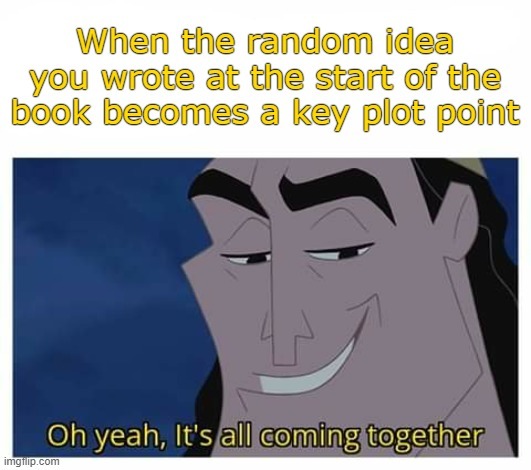
I am a writing genius who totally planned this
#writers on tumblr#writing fantasy#writer problems#writer#writing#writeblr#writing meme#author life#author problems#author meme#authors#author#book#books#wip#novel#fantasy#fiction book#fantasy fiction#writing fiction#fiction#meme#kronk#kronk meme
3K notes
·
View notes
Text
How I push through writing when I don't feel like writing.
Here are some of the techniques that I use to help me write more often or more consistantly when my laziness/depression/anxiety starts to take over.
I watch TV. I don't do it with the purpose of zoning out though. I watch something popular and well-liked such as the LOR or Harry Potter to get new ideas on how I can develop my story and apply their in-depth world-building ideas to help develop mine. Without plagarizing of course!!!!
Zoning out and daydreaming. As I have mentionned before, daydreaming is a huge part of my story outlining and world-building process. I'll stand in the shower, or take a walk and think about how my charcaters would act/react/behave in situations, mundane or not. Doing this gives me a better sense of my characters, and sometimes gives me ideas for scenes I use later on.
Work on writing related projects. These work well at keeping me distracted while still being productive on my writing goals. Example, I have one story I am working now, I made a new language (alphabet and numbers included) to include as a cool and fun component for the book. So, at times when I don't wan't to write, I continue creating the dictionary (very fun, 8/10 would recommend). Also, for the same book, my characters don't work off the Georigian calendar and 24 hour clock, so I've been working at creating a new calendar (harder than it seems, 2.5/10 dont recommend). These are side projects that help my story, without having to write.
Reading. You saw this one coming, I know. Reading is great, especially when you're editing, your writing style will unconsciously change to be more similar the author you were just reading. Also, most importantly, I'll be reading and think, "this story is really good, but you know what story I like even better? Mine." then change to writing.
This one is my biggest life saver!! I learnt about a year ago that sometimes I'll get bored of writing a story, and have difficulty keeping on track. That's why I finished my first book in 2016 and just started editing the first draft last week. The solution for me was to work on multiple projects at once, because it was much harder to be bored of multiple stories. I stick to 2, but will sometimes add a third. This is easy for me, because I have a list of over a dozen series I want to write. Don't abandon one project for another, use them as a distraction/ motivation for each other, so you're always furthering at least one project. I've never heard someone say, "oh no, i accidentally worked on this other writing project for three months instead of the other writing project I was doing. Dammit." No, we're just happy we have written something. Be sure to have well outlined story lines before starting, don't just start writing randomly or you'll reach a point where you don't know where to go from there.
Author/ writer projects. Maybe this is building a following, or community to share your projects and engage with. Tumblr, Insta, Reddit, whatever it is. My hope this year is to start up my website to offer publishing services (editing, graphic design, short writing courses) and build a following as a writer. (See what I did there? Never a bad time to self-promote ;) ) Having your own projects like this will help you in the future when you're going to try to publish and sell your books!
Talk with friends and a writing community. Never underestimate the passion that will burn inside you when talking about your story, or when others are talking about theirs. Surrounding yourself with a positive writing community can be the best thing for you as a writer.
Write or read (your story) every day. I'm not going to be one of those people that say you need to write 1000 words a day, that's a lot. But maybe try for 100? That could maybe only take 5 minutes, and at the end of the year that's still over 36 thousand words of a novel. Or just read your story, and I've always found it helped me get in the creative mood.
Make a playlist of songs that remind you of your characters, your story, or just puts you in the mood to write. Then play it ONLY when you're having trouble writing. Playing it while writing will not help, you'll get annoyed with the songs.
Just really can't do it today? That's okay, take a break. You deserve it. There's always tomorrow.
Does anyone else have ways they push themselves to keep writing? Let us know in the comments!
Happy Writing!
#novel writing#writer#author#wip#writing motivation#keep writing#writeblr#creative writing#writing advice#writing tips#writing is hard#writing help#fiction#writing fiction#writers community#how to write#writing blog#writing problems#writerscommunity#tumblr writers#writing
2K notes
·
View notes
Photo
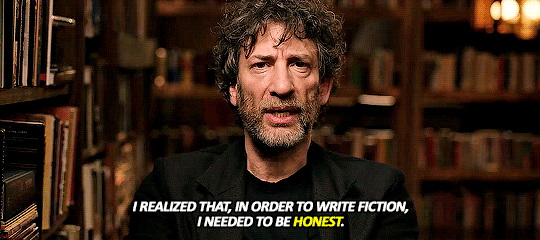

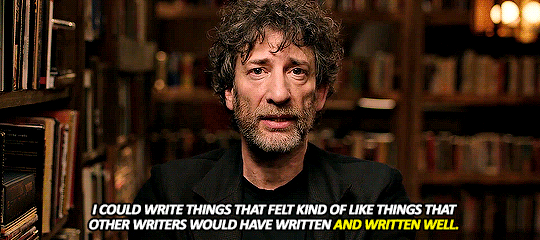

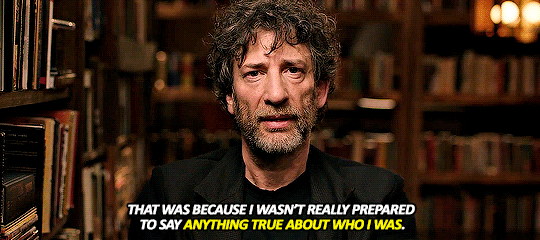
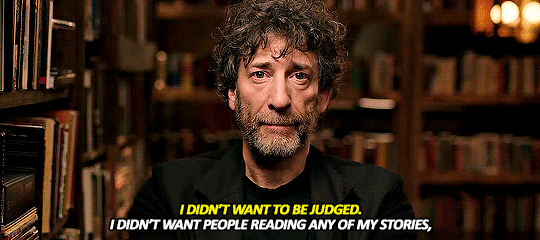

"...You had to be able to show too much of yourself. You had to be just a little bit more honest than you were comfortable with. And if people judged you, if they felt they knew who you were, that was just something that you were going to have to live with. And what was strange is, once I started doing that, and I was expecting to be judged, or shunned, or people’s opinions or to have to deal with things, what I discovered was, actually, their opinions were, we really like this. We love this story. That’s a good story. It felt huge. It felt personal. And I realized that’s because I was being honest about me.“ —Neil Gaiman
#It was such a lovely speech. I really enjoyed hearing it and I wished to have it here as well. You can youtube it. His name and Masterclass.#Neil Gaiman#The Sandman#How many of you squinted and saw Dream.#Neil Gaiman Masterclass#Dream of the Endless#You know what I WILL tag it because and I will explain#You can really see the parts of himself that Neil put into Dream#This interview more than any truly shows you some of that#Dream is essentially a creator of stories too— One who is not good at being honest with himself— One who too has a facility of voices.#Frankly— How old were you when you saw Neil's little 'self insert' OC and went 'Ah yes. Here he is.'#Also the fact that Neil always wears black and has a messy hair.#Love it.#Quote Edit#Writing Advice#Writing Fiction#buns.edits#buns.all
2K notes
·
View notes
Text
Types of government - Writing tips
Democracy - decisions by voting, whether electing a new leader or law
Dictatorship - a single, self-chosen ruler with strict limits and specific laws
Empire - ruled by an emperor. may be composed of different states, countries, or even kingdoms (in which case the emperor would have higher rank than king). emperor has absolute say.
Monarchy - ruled by a king, could be a country or kingdom part of that empire. leadership is chosen by succession (who was born next within a certain family)
Oligarchy - power is given to certain people, of a certain higher status—whether military, monetary, or titular
Federation - states or provinces that each have their own government and share a collective one, that holds more power than the provinces' government
Confederation - like the above, but the collective government holds less power
Republic - a state in which supreme power is held by the people and their elected representatives, and which has an elected or nominated president rather than a monarch.
Theocracy - a system of government in which priests rule in the name of God or a god.
Bureaucracy - a system of government in which most of the important decisions are made by state officials rather than by elected representatives.
Socialism - a political and economic theory of social organization which advocates that the means of production, distribution, and exchange should be owned or regulated by the community as a whole.
Communism - a political theory advocating class war and leading to a society in which all property is publicly owned and each person works and is paid according to their abilities and needs.
Colonialism - the policy or practice of acquiring full or partial political control over another country, occupying it with settlers, and exploiting it economically.
#writing tips#writerblr#creative writing#writblr#lyralit#writers block#writers#writing ideas#writing#writing prompts#writing advice#writing resources#writing help#writing fiction#writer tips#writers of tumblr#women writers#writerscorner#writerslife
4K notes
·
View notes
Text
#writing#fiction#creative writing#author#writerblr#writing community#indie author#writers of tumblr#my writing#writer#fiction writing#am writing#book writing#fantasy writing#novel writing#story writing#writing advice#writing blog#writing characters#writing fiction#writing meme#writing inspiration#writing mood#writing on tumblr#writing problems#writing resources#writing progress#writing things#writing stuff#writing tips
188 notes
·
View notes
Text
here's some random writing advice that i've found helpful, in no order, that i reserve the right to add to at any time:
no one says everything they're thinking. in dialogue, less is more. people don't speak in paragraphs, they speak in sentences, especially when they're not telling a story. let the dialogue be brief, and use interiority (thoughts) to show the reader all the things they aren't saying.
use physical cues to help the POV character understand what the non-POV character is thinking/feeling/not saying/lying about. For example, if we're in Jane's POV while Maura is talking, and Maura says "I'm fine," Jane can notice that her eyes are darting around like she's anxious, or she's crossed and uncrossed her arms, almost like she's nervous. there's no need to say MAURA SEEMS NERVOUS, let the reader get it from what Jane's picking up.
let the reader be curious—don't info dump—but don't frustrate them by giving so little that they don't know what's going on. this is a very very fine line sometimes, and betas can be really helpful for pointing it out until you've gotten the feel for it.
Use paragraph breaks, for the love of god.
Only italicize things that really and truly cannot be explained any other way. "What are you doing here?" for example doesn't need any italics. If you can't get the reader to understand what you mean without the italics, then, sure, use them. but SPARINGLY. use body language, interiority, other words, and dialogue tags (shouts, yells, whispers, cries, she says as her voice cracks) to get the reader what they need.
"What are you doing here?" could be "what on earth are you doing here?" (aka, i have no fucking idea why you're here, my dude)
"What are you doing here?" could be "i told you to stay out of this, lucy! what are you doing here?" (aka, lucy you specifically should not be here)
"What are you doing here?" could be "jesus, you scared the shit out of me! I thought you were at the front! what are you doing here?" (aka, i'm not surprised to see you, but i'm surprised to see you HERE what the fuck)
Don't head hop. Know who's POV you're in and STAY IN IT until the chapter break, scene change that's clearly indicated by ***, whatever. if this is challenge, try writing in first person to get in the habit of only knowing what your POV character knows. There is, of course, 3rd person omniscient narration, but it's really fucking hard to pull off and honestly I recommend staying away from it entirely. Most things you'll read are written in first or close 3rd, and that's not an accident.
Let your characters move around in space. let them notice the things around them.
If Kate walks into a room, i'll probably list what she sees in order of importance, unless it's a big reveal. i'll add voice to that so you'll know i did it on purpose.
in order of appearance: "the body lies in the middle of the big, wide room. the ceiling must be twenty feet up, and there are plenty of windows, the way the light catches the falling dust mites looks more like a church than a crime scene."
with reveal/voice: "Kate bursts into the room and immediately skids to a stop. it's too bright, all white walls and high windows. it looks like the kind of room you'd put a WeWork in, or maybe a super expensive soulcycle. normally Kate would be itching for a paint roller and some blueprints, but today she ignores the terrible architectural choices, choosing to focus instead on the dead body congealing in a puddle of dark brown blood in the middle of the floor."
try to have an internal plot/obstacle (alex can't be honest with maggie about their relationship because she hasn't told her that her sister is superhero) and external plot/obstacle (there is a serial killer targeting aliens in national city, and all three women are on his radar). Best practice is for them to intersect and create layered, complex problems (maggie can't understand why alex is so fucking freaked out about this serial killer in the first act; yes, crime is bad, but like, it's their job? why won't alex TALK to her? where does she keep running off to in secret? does alex even actually want to be with her??)
Everything should have: tension, stakes, obstacles. Try not to make all of that hinge on a misunderstanding or one person being too chicken to confess their feelings. that gets boring and frustrating for the reader.
If you need to make a calendar, make one. If you need a cast list, write one. keep yourself on track.
introduce new original characters slowly. give them one name (first and last is usually not necessary at the start). give us one or two things to remember about them. Jenna is the producer of the tv show. Jenna is mean. the next time she comes back, call her "jenna the producer." then the next time you can hint to her role, like "jenna has her big clipboard and is shouting at everyone to get the fucking cameras ready." if jenna doesn't come back again, don't name her. be kind to your readers who forget things, and help them out by limiting the named cast to people who need to be named. if they don't show up until halfway through, don't introduce them until halfway through. for fanfic, obviously this is easier because we know everyone, but still, please. only have the people in the scene who need to be there. huge scenes with 5-8+ characters present are a MESS.
if your character has two best friends who fill the same role, cut one. streamline so i as the reader have less to keep track of.
banter can be fun to write, but dialogue without movement, choreography, internal thoughts, lies, physical cues, and plot movement gets really boring to read. if a scene is skippable, ask yourself what would make it essential, and add that.
every conversation should do at least two things. things can be:
move the plot forward
deepen, change, or complexify an existing relationship
create tension (plot, romance, etc)
explore stakes
attempt to get over the obstacle
FOR EXAMPLE: Helena and Myka almost kissing when they shouldn't because Helena is with Some Dude? yes! that's romantic tension and attempting to get over the obstacle (some dude). Myka rambling to claudia about almost kissing helena for 3 pages: no! That does nothing on this list. the event already happened, and a long debrief about it isn't interesting to the reader. Let Myka ruminate while she's doing one of the other things. and by ruminate, i mean KEEP A LIGHT TOUCH HERE, ruminating is very very easy to make boring and maudlin. trust your reader; be subtle about it.
100 notes
·
View notes
Text
Quick Tips on Writing Better Characters
Here are a handful of quick tips to writing stronger characters and understanding them better as a writer.
Give your characters a title. This can help with worldbuilding and placing your protagonist into the environment. What do others call your characters? The emperor, the bastard son, the Grinch, the chosen one, the class clown, the evil witch, the popular girl, etc.
Use your settings to enhance your character. You can use the locations of your novel to mirror or contrast your character. Do they blend in or stand out? What they focus on can say a lot about them (ex. a fearsome character mishearing things on a dark street, a princess in a ballroom only focused on the exit.)
Know your protagonist's motives and goals before you start writing. What is something they need that fuels their actions throughout the novel? Money, freedom, an artifact, food? To protect their sister at all costs and survive the Hunger Games?
Now that you know their motive, make it more complex. A character's motive can be made more complex by putting them in high-stake situations that force them to make decisions. For example, Katniss wants to protect her sister, a very common motivation. However, present-day conflict makes her to do it in the most extreme way by volunteering in the Hunger Games. The plot forces her to make an extreme choice fueled by her motivation.
Your protagonist should be active. It's okay to have your story's events sometimes happen to your character (this is referred to as the character being passive, ex. a tornado sweeping them away) but your protagonist should be active a majority of the time. This means they should always be making decisions, thinking, reflecting and progressing through obstacles.
Instagram: coffeebeanwriting
#writing tips and tricks#writing tips#writing advice#creative writing#writeblr#writing blog#how to write#writing help#writing fiction#writing prompts#fantasy writing#authortips#authoradvice#writingtips#writingmemes#writers blog#writingblog#authorsblog#howtowrite#writingtipsandtricks#writerscommunity#writers community#writinghelp#writingprompts#writertips#howtowriteascene#writingfiction#fictionwriting#fantasywriting#writing memes
2K notes
·
View notes
Note
I need a word for horny but not in a sexual way more just like wanting kisses and hugs and affection or something
This is a great question!
The best way to write about desire in a way that makes readers feel invested is to write around it.
Instead of using just a single word, use language that hints at something simmering below the surface. That way, you build tension for your readers, making them invested in the outcome of your characters' relationships.
Here are some tips for how to write romantic desire in various ways (including some handy synonyms at the end as well).
Unconscious movements
Covert glances
Licking and biting lips
Mirroring the other's movements
Parting or crossing of legs
Touching one's own skin
Swallowing more than usual
Blinking rapidly
Short breaths
Playing with one's hair
Fidgeting
Leaning closer than usual
Internal feelings
A fluttering heartbeat
Comfort in the other's presence
Knots in your stomach
The sensation of other sounds being muffled
Nervous tingling
Short of breath
Hypersensitivity
Sudden weakness
Thumping pulse
Emotional overwhelm
Goosebumps
Behaviours
Surrounding oneself with reminders of the object of desire (like things that smell of them, or an object they hold dear)
Creating reasons to spend more time with the other person
Loss of inhibition
Impatience and irritability
Setting active goals to attain the object of desire
Conscious and subconscious fixation
Changing oneself to better suit the other's wants
Feigning other interests to promote jealousy
Showing resolved desire
Finally feeling personally fulfilled
A sense of calm and peace
A shift in focus from pursuit to personal happiness
Feelings of contentment
A change of life priorities
Feeling like an obstacle has been overcome
A more relaxed manner or expression
Personal and romantic growth
Showing unrequited desire
Pining for lost love
Frustration and anger
Bottling one's feelings
Living in denial
Feeling rejected
Falling into a personally damaging pattern of pining for the wrong people
Strained friendships
A sense of disconnection and isolation
Some handy synonyms
Craving
Longing
Yearning
Wanting
Hunger
Thirst
Covet
Infatuation
Obsession
Attraction
Passion
Fascination
Lust
Pining
Aching
Burning
Need
Love
Devotion
Rapture
Appetite
Frenzy
Frisky
Amorous (thank you, @quotidias, for the contribution!)
#writing tips#writing#writers#creative writing#writeblr#novlr#writing advice#writing resources#writerblr#aspiring author#writing community#writing fiction#novel writing#character development#show don't tell#writer things#just write#creative writers#creative inspiration#writing inspiration#learn to write#writing help#helping writers#young writers#write with me
675 notes
·
View notes
Text
Vocabulary
Words to Describe Sound
✷
↠ bang
↠ bark
↠ beep
↠ bellow
↠ blare
↠ blast
↠ bong
↠ boom
↠ buzz
↠ cackle
↠ cheep
↠ chime
↠ chirp
↠ clack
↠ clang
↠ clank
↠ clap
↠ clatter
↠ click
↠ clink
↠ cluck
↠ clunk
↠ crack
↠ crackle
↠ crash
↠ creak
↠ crinkle
↠ drip
↠ drum
↠ fizz
↠ gnash
↠ gobble
↠ grate
↠ grind
↠ groan
↠ growl
↠ grumble
↠ grunt
↠ gurgle
↠ hiss
↠ hoot
↠ howl
↠ hum
↠ jangle
↠ jingle
↠ knock
↠ moan
↠ neigh
↠ patter
↠ peep
↠ ping
↠ pop
↠ pound
↠ pow
↠ pulse
↠ purr
↠ rap
↠ rattle
↠ ring
↠ ripple
↠ roar
↠ rumble
↠ rustle
↠ scream
↠ screech
↠ scrunch
↠ shriek
↠ sizzle
↠ slam
↠ snap
↠ snarl
↠ snort
↠ splash
↠ sputter
↠ squak
↠ squeal
↠ squeek
↠ squish
↠ stamp
↠ swish
↠ swoosh
↠ tap
↠ tear
↠ throb
↠ thud
↠ thump
↠ thunder
↠ tick
↠ tinkle
↠ toot
↠ trill
↠ twang
↠ twitter
↠ wail
↠ wheeze
↠ whine
↠ whisper
↠ yap
↠ yelp
↠ zap
#writing#writing tips#story ideas#reference#knowledge#writing reference#vocabulary#synonyms#writing help#writing words#writing fiction#writing inspiration#writing advice#senses#creative writing
4K notes
·
View notes
Text

When you're in a writing mood but also falling asleep
#writers on tumblr#writing fantasy#writer problems#writer#writing#writeblr#writing meme#author life#author problems#author meme#authors#author#book#books#wip#novel#fantasy#fiction book#fantasy fiction#writing fiction#fiction#meme#mr incredible#mr incredible meme#the incredibles meme#the incredibles#tired#tired meme
2K notes
·
View notes
Text
Okay, I guess this is my Writeblr intro!
Pretty new to this, so here goes nothing...
Greetings, Writeblr!
My name's Chris (he/him), I'm 27, currently based in Philadelphia. I'm a visual artist, specializing in 2D media and illustration, and I'm also an avid lover of Fiction and Storytelling!
Naturally, the sum of these interests manifests itself as a love for Comics and Sequential Art; with that being said, the majority of my Fiction Writing is for comics and graphic novels.
I started my journey in learning to write fiction a few years ago; i always had a love for Story, whether it be books, shows, comics, movies.... if there's a Compelling Narrative and Compelling Characters, chances are I'm all over it!
My current WIP is a Sci-Fi, Cosmic Horror, Sports Drama Graphic novel series, called OneFall: a Dystopian, Cyberpunk world of Lovecraftian horror, compounded with the action-packed, fast-paced world of Pro-Wrestling, injected with themes of identity, feminism, revolution, and reconciling with past trauma. If this sounds like an interesting (albeit unorthodox) combination, then maybe this comic is for you!
As you might've guessed, I tend to write (and read) in the genres of Action-Adventure, Sci-fi, and Horror, but I tend to dip my feet in whatever catches my interest.
While I'm no stranger to this site, I'm fairly new to this neck of the woods, so... feel free to say hi!
Where my fellow writers at?
#writeblr#comics#artist#writing#creative writing#writing comics#fiction#writing fiction#writers on tumblr#writerscommunity#pro wrestling#pro wrestling women#womens wrestling#graphic novel#on writing#writeblr intro#putting myself out there#looking to connect with some more writers
59 notes
·
View notes
Text
So you want to write about horses.
Specifically, you want to write about horses in your medieval-inspired fantasy novel, rpg, or daydream fantasy. Knights in shinning armor on noble steeds, damsels in distress(or not!) on fine prancing mount, or an evil sorcerer cackling on a fierce charger above your poor tandem MCs.
Whatever it is you're imagining, a medieval horse appears. But you know nothing about horses. I can help.
(If you would like to begin with my first basic Basics post, start here)
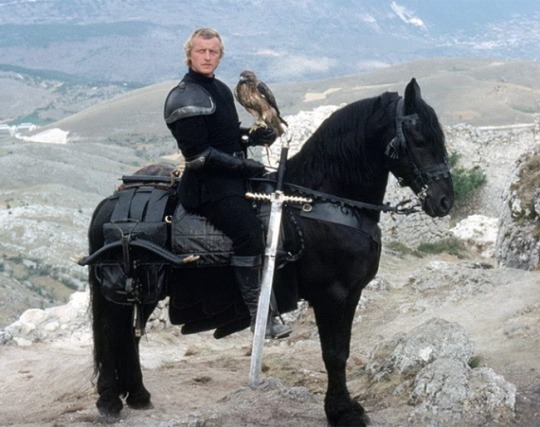
^ When thinking knight, you're probably imagining a horse like this.
Preface: When talking about fiction, there is always a question of historical accuracy. That is wholly up to you. But you will at least, after reading this, know more of the historical fact involving horses, and certainly know about some of the more commonly-complained about fallacies involving horses in media.
Now, the above still is from the film Ladyhawke (1985), which is often credited for popularizing the Friesian breed in the United States. I can almost guarantee you have see a Friesian in a film or on TV. The recent series Shadow and Bone had a central character ride a Friesian in one episode. They epitomize the romantic nobility and grace of knights. Except they don't.
The horse you see above came into existence in 1879, primarily as a harness and agricultural use horse. Horses known as Friesian horses have existed since the 11th century, but those horses were completely different from the breed created in the 19th century. The modern Friesian is a trotting breed, made to pull carriages and look beautiful doing it. They have a long back, short neck, and due to inbreeding, a host of nasty genetic problems including dwarfism, aortic rupture, hydrocephalus, and megaesophagus.
However, breeds that trace ancestry back to beyond the middle ages do exist, and they have been breed to look much the same for generations. Introducing:
The Barb/Berber Horse
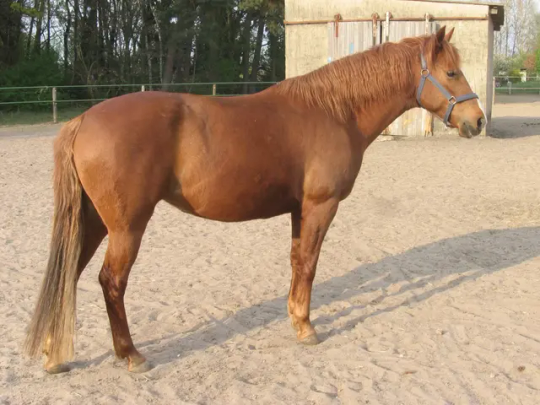
^Kinda just looks like A Horse™
The Barb comes from North Africa, and was spread into Europe through the Muslim conquest of Spain, where the breed mixed with the native Andalusian breed to create the Spanish Jennet, which is possibly the most widely successful horse breed in all of history. The Jennet is currently extinct*, but due to its durability, it was the horse used by the Spanish AND the British to invade the Americas, and descendants of the Jennet survive in local breeds from Argentina to Canada.
*a revitalization breed does exist of the same name
The Andalusian/Lusitano/Pure Raza Espanol
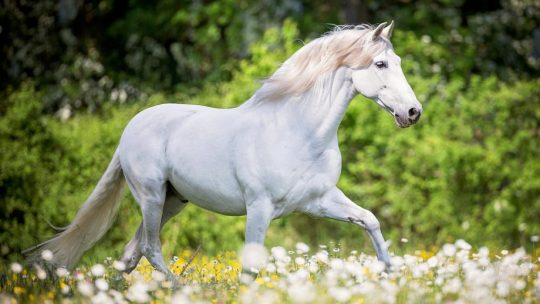
^The true Fabio of horses, known for thick flowing locks and sweet dispositions
Possibly the horse that most strongly resembles the ancient knighly horse, this noble creature used to be the preferred horse of film, before the Friesian rise in popularity. Horses of Spanish bloodlines are Andalusian, horses of Portuguese bloodlines are Lusitano, but the characteristics of both breeds are nearly identical. They are also known for a fancy 'high stepping' movement, in which they raise their knees higher than other breeds naturally.
The Arabian
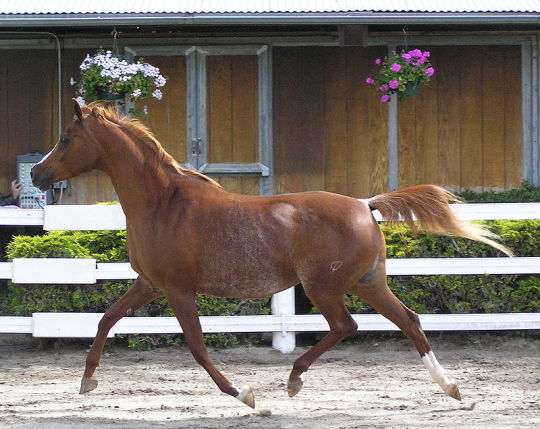
^Note the narrow, 'dished' face and raised tail, breed characteristics
The ancient horse of the desert, made famous through books such as The Black Stallion, King of the Wind, and films such as Hildago. These horses are known for their stamina and intelligence, and were traditionally used as war horses by the desert tribes of the Arabian Peninsula. The Arabian has descendants in almost all modern breeds, as it is used to add strength and stamina to the original stock, despite being a relatively small horse. During the Napoleonic wars, this horse became the prized war horse of Europe as well, with Napoleon himself preferring to ride Arabians into battle.
The Mongolian Horse
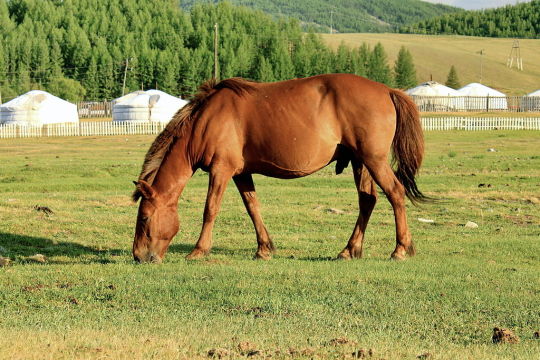
^Thick head, thick body, this horse is made to survive winter on the steppes
Introduced to Europe from the Hunnic invasions that ended the rule of Rome, the Mongolian horse is made to survive, thrive, and run in harsh cold weather. This horse allowed Ghengis Khan and his soldiers to conqure one of the largest empires to ever exist, from Korea to Poland. This compact horse would have mixed with the native stock of Russian, Eastern European, and Germanic tribes to help create the ancient northern horses, resulting in a thicker breed of horse in the north, and a lighter breed of horse in the south of Europe. Modern-day pony breeds such as the Exmoor, Fjord, Icelandic, and other have been found to have genetic ties to the Mongolian horse.
These horses do not exactly look like the modern image of knights on massive horses, but it is useful to remember that 1. people back then were a lot smaller and 2. horses back then were a lot smaller. Of course, there were hundreds of other local breeds during the middle ages, but many have been modernized and become today's sport, work, or pleasure horses.
During the middle ages, horses were not actually defined by breed. They were defined by the work the horse was suited and trained to preform. There were five main types of medieval horses.
The Destrier
Also called The Great Horse for its size, strength, and price, this horse was the renown mount of knights and kings in battle. These horses were highly trained for battle, and could be taught to do such things as striking out at soldiers in front, kicking at soldiers from the back, and even leaping all four feet in the air to protect it's rider. They would wear the most armor, and these horses would likely be closest in appearance to the modern Andalusian.

^Ornate heavy armor on a model horse. This armor was made for a horse not much more than 15hh, what today would be a small horse.
The Courser/The Charger
A lighter horse than the destrier, the courser is also a warhorse, highly trained and well-bred, but a little less expensive. A knight might not be able to afford a destrier, especially as a minor knight, but every knight should have a courser. The Spanish Jennet is the epitome of the medieval courser, and in fact was the horse used by Richard II. According to Shakespeare, the horse's name was White Surrey, although other sources claim the horse was Roan Barbary, and was a Barb or Berber horse*.
*Bought from Spain and likely a cross of Spanish and African blood, so a Jennet. But Jennet was also a classification of a horse type in those days, so, sources are muddled.
The Rouncey
The 'average' horse of the time, this horse was used mainly for riding, but could sometimes be ridden into battle if trained properly, and were the preferred horse for lower-class fighters such as archers or men-at-arms. As it described a riding horse, these horses came in all shapes and sizes, from all lineages, and in all colors. In peacetime they could be used to draw carriages or work fields. A proud and expensive destrier would never be caught pulling a plow.
The Palfrey
A highly-bred, highly trained horse, this horse is a high quality riding horse known for a specific gait, called an ambling gait. This horse had a special pattern of moving its feet that gave the rider a considerably more comfortable ride than the traditional 4 gaited horse. After the middle ages, these horses almost disappeared, only to be recovered in the Americas in the form of 'gaited' horses such as the Paso Fino, the Rocky Mountain Horse, the Missouri Foxtrotter, and the Tennessee Walking Horse. The Icelandic horse has also retained the special Tölt gait that may* be the exact gait of medieval ambling horses.
*may, I am not a gaited horse expert.
The Packhorse
This describes any kind of horse, usually a rouncey, that is used not for riding but to carry supplies. Packhorses could also be mules, donkeys, and ponies, so long as they could carry weight for long miles. These were supply horses, carrying food, weapons, tents, whatever else may be needed.
Knights, Horses, and the Battlefield
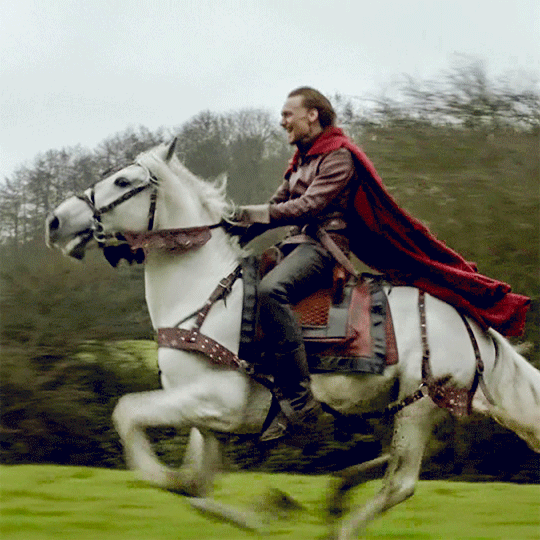
^ What an incredible creature of power and nobility. The man is fine too, I guess.
Now, if you have seen the above scene, you have probably seen The Hollow Crown, a historical drama with a few late Medieval battle scenes. In these scenes, knight clashes against knight in a furious charge, leading to pitched battles on horseback. I'm not going to say that never happened, but by and large cavalry was directed against infantry, not other cavalry, or used to conduct maneuvers requiring speed and surprise, such as a charge, a circling maneuver, a bluff retreat and most importantly, to chase down routing enemy soldiers. A knight on horseback was most effective in close quarters against unmounted and surprised soldiers. Lances were the primary weapon, allowing a mounted warrior length to spear and batter down at enemies, and a sword was secondary, as it had a shorter length, and would be used if a mounted warrior was surrounded by infantry or in battle against another knight. Throughout the medieval period, horses sometimes were removed from the fight all together due to unfavorable land, and kept in reserve to either help the army flee or to chase down the fleeing enemy.
Hungry for more?
There are many sources out there to learn more about the medieval period and knights in particular. I would highly recommend that you not look at Medieval Times sources, if only because better sources are out there. I enjoy the videos produce by Jason Kingsley CBE (Yes, that Jason Kingsley CBE) on his Modern History TV YouTube Channel, and find them to be accurate as far as I'm aware.
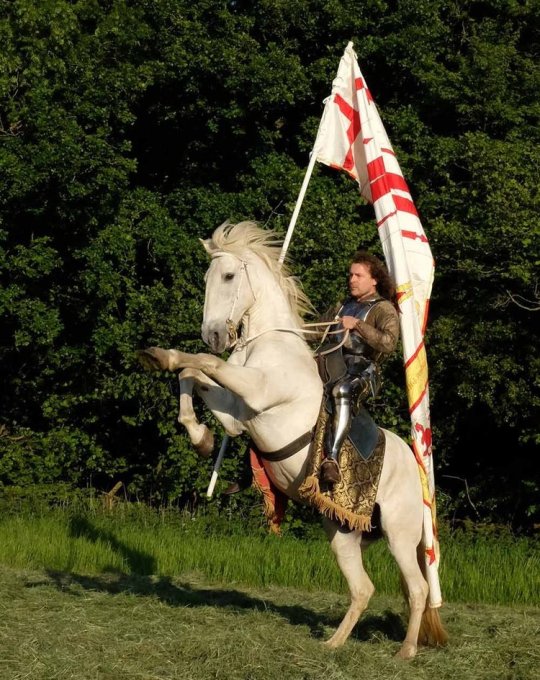
^ Jason Kingsley and his horse Warlord, in costume. I've sent marriage proposals but I've not yet received a reply.
That's all for this post. I'll have more when I feel like it, and send me questions if you want to know more about specific things or need a writing question answered
Reblogs welcome and encouraged
@jacqueswriteblrlibrary for wider reach
#writing#writeblr#writing horses#how to write horses#writer advice#writing help#writeblr community#writers on tumblr#writers#writerscommunity#creative writing#horses#how to write#advice post#medieval knights#writing medieval horses#horses in film and media#writing fiction#writer stuff#writing fantasy#writing historical fiction
78 notes
·
View notes